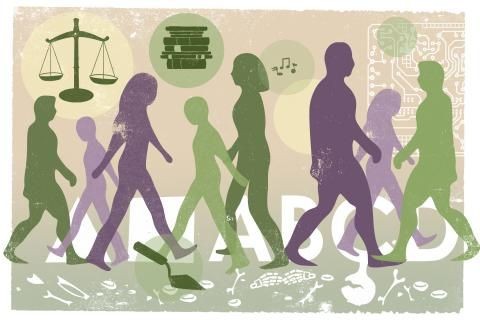
Applied Anthropology
1. Introduction to Applied Anthropology
The vast expansion of fields of application has fundamentally transformed the ways in which anthropologists can study and understand human society and culture and has led to questioning the traditional distinction between an industrialized western society and other societies. Applied anthropologists are quite expressly concerned with practical problems, more often than not taking them as the starting point for their research. This focus on problems has intensified the comparative focus of anthropological research. Applied anthropologists rarely assume that a problem is structured the same in all societies, and their research generally involves clarifying the nature and impact of the problem within the society or culture in question. Applied anthropologists often need to collaborate with certain segments of the population or with institutions, and this means that they are likely to engage in research which is actively involving those they are studying.
The term applied anthropology dates back to 1906, and it refers to an anthropological perspective, theory, or method that is put to practical uses such as technological development, policy formation, medicine, and business. Influences from social theory, social and cultural research methodology, on the one hand, and from the anthropological and ethnographic tradition on the other, have been harnessed, contributing to a major development in the social and cultural research industry across the world since the Second World War. Despite this topical importance, applied anthropology has received less attention from anthropologists and philosophers of social science than might be expected. However, its impetus has led to many stimulating theoretical developments in the understanding of the nature of human societies and cultures and the nature of their changes.
2. Key Concepts in Applied Anthropology
Interested in putting things together, applied anthropologists have tended to mix and match theories and methods from a variety of sources, sometimes to confusing or contradictory result. Still, it is one of the few fields in social science which is explicitly anti-disciplinary. In both theory and practice, it tries to blend the macro and micro perspectives, the biological and the social domains, and the academic and the advocacy roles. While knowledge employed may be imbalanced due to the western origins of the discipline, it is at least the intention to function in this fashion in order to affect every dimension of the problem or possibility at hand.
Articulating key concepts of applied anthropology is nearly impossible because of the discipline’s comprehensive nature. Different courses and advisors will stress various elements over others, but there are several concepts which are more or less central to the field. Holism is often cited as the field’s most distinguishing characteristic. Where other social sciences will look at a segment of a particular society, culture, or epoch, applied anthropology aims to examine the whole picture—the totality of human society and culture. This has been both a strength and a weakness.
3. Methods and Approaches in Applied Anthropology
This section has the ambitious goal of surveying the major methods and approaches used by applied anthropologists both in the past and today. This chapter on methods, however, will not be confined to the social/behavioral side of the discipline. These are not merely techniques for data collection or scaling, but historical traditions that contain a distinct way of viewing and understanding the world. Therefore, it is essential in learning a particular method to understand the context in which it was used by the people who created it. For instance, when a psychologist interviews a member of a culture to gain information about that culture, his/her methods are very different from the ethnographic interviewing tradition that we would like to describe. While he is using a tool designed to gain psychological information, the traditional anthropological interview aims to maximize understanding of the other person’s point of view. Therefore, it is quite possible for two researchers to share a method, yet one is doing psychological research and the other is doing research that is quite interpretative and meaning-centered. With that in mind, we have divided our discussion on methods into the two major sides of the discipline.
4. Case Studies in Applied Anthropology
The major section for “Applied Anthropology in Administration and Policy” shines with the essay by Elizabeth M. Eddy, which examines a federally-funded employment-training program intended to build up better-educated manpower in the healthcare sector. The program recruited students, successful mid-career changers, and seasoned displaced workers, training them in hospital and academic settings for paraprofessional occupations. The program designers envisioned that a cadre of new health workers could effect eventual improvement in the US healthcare system, but the unexpected complexities, twists, and dilemmas of attempting to improve a sector while working within it are vibrantly documented here. Eddy examines the historical, political, and organizational forces that buffeted her own involvement as an applied anthropologist in a scheme evaluative study, and she interrogates the difficult-to-measure effects of anthropological input on altering a program after its initial design phase. This essay is a boon for student anthropologists interested in employment and training, medical anthropology, or the interface of anthropology and public policy.
5. Ethical Considerations in Applied Anthropology
The second key ethical dilemma identified by Campbell and Rew surrounds issues of informed consent. They state that changes in power relations between anthropologists and those being studied, coupled with cultural differences in understandings of research, have rendered the issue of informed consent more complex. This is particularly the case with research involving marginalized or vulnerable groups. Fassin (2005) provides an example of this with a study of a group of homeless people. He reflects that while they gave their verbal consent for the study, he had “forced” them to participate because they were reliant on the money he paid them. He questions whether the actual consent, given the power relation between him and his informants, was equivalent to that expected in the ethical guidelines of his own society. Fassin also raises the issue of consent from receiving communities when research is initiated by external agents. In a case where an anthropologist is contracted by an organization to conduct research, it may be that the people who will be affected by the research have had no input in the decision but the consent of their representatives will be taken as sufficient. This was the case with a study of the impacts of oil company policies on a group of Colombian peasants, where the anthropologists obtained consent from community leaders but the actual agreement from community members was unclear (ibid: 48).
Ethical considerations in applied anthropology have received significant attention in recent decades as a result of the sensitive nature of much of the research pursued in applied anthropology. Campbell and Rew (1999) comment that there are two chief ethical dilemmas which have arisen in the application of anthropological methods to decision-making processes in contemporary societies. They argue that often there will be a conflict of interest between the anthropologist’s responsibility to his sponsors and his commitment to objective social science. In the worst-case scenario, this may involve the suppression or manipulation of findings to avoid embarrassment to the sponsor (Stocking 1992). Another form of this dilemma arises when the anthropologist becomes an advocate or activist for the people being studied. The conflict here lies between the responsibility to those studied and responsibility to the data. This type of advocacy may be perceived by decision-makers as a breach of contract and may damage the future prospects of anthropological work in similar fields (Campbell and Rew: 174).








Профессиональный сервисный центр по ремонту бытовой техники с выездом на дом.
Мы предлагаем:сервис центры бытовой техники москва
Наши мастера оперативно устранят неисправности вашего устройства в сервисе или с выездом на дом!